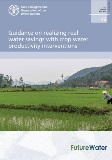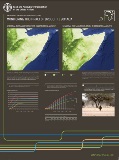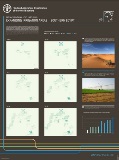Water accounting
Understanding the current status of water resources systems globally requires detailed information on the source of water in space and time as well as detailed information on the utilisation of those water resources. Unavailability of sufficient observed data is a big issue in most parts of the world to be able to fully assess available water resources and its utilisation. Fortunately, more and more remote sensing based products are becoming available, providing information on various components of the water cycle, such as precipitation, actual evapotranspiration and storage variations.

Geospatial assessment of cultivated cropland extent in the Sudan: July to September 2023
21/11/2023
A rapid assessment was conducted in July, August, and September 2023 to estimate the extent of cultivated cropland in Sudan, considering the disruption caused by armed conflict, using geospatial data to inform immediate and long-term food security management.

Remote sensing determination of evapotranspiration: algorithms, strengths, weaknesses, uncertainty and best fit-for-purpose
23/10/2023
The publication aims to update the knowledge and enhance the capacity of water professionals, raise awareness of the strengths and limitations of remote sensing models and databases for evapotranspiration, and clarify operational aspects such as spatial and temporal resolutions and accuracy. Ultimately, it serves as a valuable reference for water actors and professionals working towards sustainable water resource management.
La contabilidad del agua en la cuenca del Litani
01/01/2019
Este informe presenta el estudio de contabilidad del agua de la cuenca del río Litani, Líbano, realizado por el IHE-Delft utilizando el portal WaPOR de la FAO. La cuenca del río Litani es una de las cuencas fluviales clave en el Líbano y está experimentando escasez de agua. Los crecientes desafíos, como el aumento de la población, el cambio climático, la sobreexplotación de las aguas subterráneas y los trasvases entre cuencas, han puesto bajo presión los recursos hídricos disponibles.

Recueil de Comptabilité et d’Audit de l’Eau
09/10/2020
French version of the publication "Water Accounting and Auditing: A Sourcebook" FAO, together with other organizations, recommends water accounting and auditing as being fundamental to initiatives that aim to cope with water scarcity. This sourcebook wants to provide advice on the application and use of water accounting and auditing, helping users planning and implementing processes that best fit their needs.

WaPOR 2: using remote sensing in support of solutions to reduce agricultural water productivity gaps
06/07/2021
This flyer introduces WaPOR to potential users and to stakeholders involved in WaPOR projects. It sheds light both on the project itself and the portal that contains the data. It is also available in French, Portuguese, and Arabic.

Irrigating from space: using remote sensing for agricultural water management
22/03/2023
This brief was produced by the FAO Investment Center under the FAO-World Bank Cooperative Programme and proposes concrete applications of WaPOR data in irrigation management by exploring the case of the Bekaa Valley.

Yield gap analysis of field crops. Methods and case studies
01/01/2015
The publication reviews methods for yield gap analysis, clarifying definitions and techniques to measure and model actual, attainable and potential yield at different scales in space and time and using case studies to illustrate different approaches.

Guidance on realizing real water savings with crop water productivity interventions
05/03/2021
This technical document contains clear and practical guidelines on how to implement real water savings in agriculture through interventions for enhancing crop water productivity. A distinction is made between real water savings and “apparent” water savings.

The State of the World’s Land and Water Resources for Food and Agriculture 2011: managing systems at risk
01/01/2011
The report analyses a variety of options for overcoming constraints and improving resource management in systems at risk. In each location, a mix of changes in institutional and policy measures will have to be combined with greater access to technologies for better management of land and water resources. Also available in French, Arabic and Spanish.

Map story: the use of WaPOR data in the cultivation of sugarcane
24/08/2021
This map story shows the way that productivity analysis can be carried with WaPOR data in order to understand the spatially explicit attainable water and land productivities of an area of interest, identify the zones where these productivities are met and derive from that analysis best practices to increase the productivity of the area as a whole with the goal of producing more while using less water.

Map story: WaPOR data for groundwater monitoring
22/03/2022
This map story explores the potential of the use of WaPOR data to assist in the monitoring of groundwater abstraction in the Azraq basin, a basin that is the second most exploited in Jordan. Also, it goes to show the potential of pyWaPOR as a tool to extend the coverage of higher resolution WaPOR data to new areas of high relevance.









